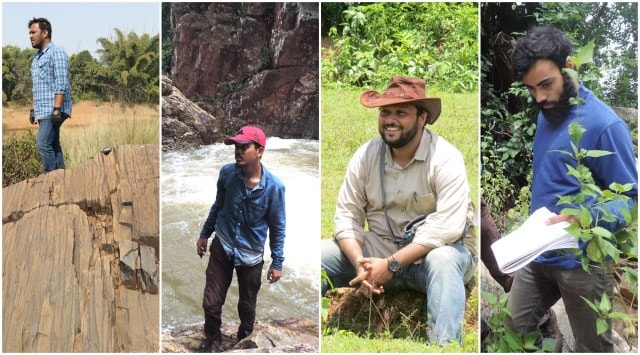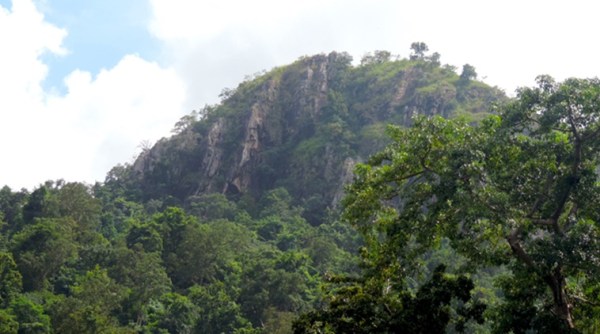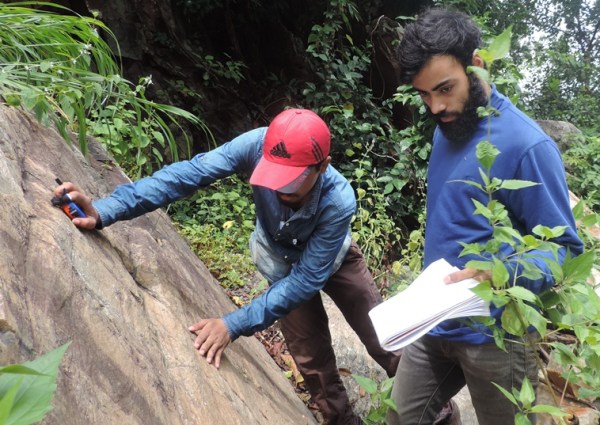- India
- International
Jharkhand’s Singhbhum region may have been earliest continental land to rise above ocean, reveals study
Scientists from India, Australia and the US have found that the Earth’s first continents emerged from the ocean 700 million years earlier than thought.
 (From left) Priyadarshi Chowdhury, Subhajit Roy, Subham Mukherjee and Surjyendu Bhattacharjee during their research work in Jharkhand. (Photo: Special Arrangement)
(From left) Priyadarshi Chowdhury, Subhajit Roy, Subham Mukherjee and Surjyendu Bhattacharjee during their research work in Jharkhand. (Photo: Special Arrangement)Researchers have always been intrigued about when the landmasses we reside on came into existence and till recently, it was widely accepted that continents rose out of the ocean about 2.5 billion years ago. However, a recent study has changed that notion.
A recent research has shown that the Earth’s first continents may have risen out of the ocean about 700 million years earlier than previously thought. And to the surprise of many, the earliest continental land to have risen about 3.2 billion years ago may have been Jharkhand’s Singhbhum region. Scientists from India, Australia and the US have found sandstones in Singhbhum with geological signatures of ancient river channels, tidal plains and beaches over 3.2 billion years old, representing the earliest crust exposed to air.
When asked as to how Singhbhum came into the picture of research related to Earth Sciences, Dr Priyadarshi Chowdhury of Monash University, the study’s lead author, told indianexpress.com that the answer to “when the first landmasses were formed lay in the sedimentary rocks of the region”.
“We found a particular type of sedimentary rocks, called sandstones. We then tried to find their age and in which conditions they have formed. We found the age by analysing the uranium and lead contents of tiny minerals. These rocks are 3.1 billion years old, and were formed in ancient rivers, beaches, and shallow seas. All these water bodies could have only existed if there was continental land. Thus, we inferred that the Singhbhum region was above the ocean before 3.1 billion years ago,” Chowdhury said.
 The Singhbhum region where the research was carried out. (Photo: Special Arrangement)
The Singhbhum region where the research was carried out. (Photo: Special Arrangement)
But, Chowdhury said, patches of the earliest continental land also exist in Australia and South Africa.

Speaking about how they determined that the region rose above ocean during the timeframe mentioned above, Chowdhury explained: “We studied the granites that form the continental crust of the Singhbhum region. These granites are 3.5 to 3.1 billion years old and formed through extensive volcanism that happened about 35-45 km deep inside the Earth and continued on-and-off for hundreds of millions of years until all the magma solidified to form a thick continental crust in the area. Due to the thickness and less density, the continental crust emerged above surrounding oceanic crust owing to buoyancy.”
“This is the most direct, unambiguous date yet for the emergence of continental land,” Chowdhury said. The findings have appeared in the Proceedings of the National Academy of Sciences, a US research journal.
The research also tends to break another well-accepted notion: continents rose above the ocean due to plate tectonics, which is the major driver today for increases in the elevation of land masses.
 Two of the researchers during their study in the Singhbhum region. (Photo: Special Arrangement)
Two of the researchers during their study in the Singhbhum region. (Photo: Special Arrangement)
“We have plate tectonics today to control the elevation. When two continents’ (plates) collide, you form the Himalayas, you form the Alps,” he said. “That wasn’t the case 3 billion years [ago]. The first continents probably rose above sea level as they were inflated by progressive injection of magma derived from deep in the Earth.”
The researchers believe that the earliest emergence of continents would have contributed to the proliferation of photosynthetic organisms, which would have increased oxygen levels in the atmosphere. “Once you create land, what you also create is shallow seas, like lagoons,” Chowdhury added, accelerating the growth of oxygen-producing life forms that may have boosted oxygen in the atmosphere and ocean.
Exhorting on the importance of such studies, Chowdhury said that at a time when the entire world was debating about changes in climate, it is very important to understand how our atmosphere, oceans and climate came into existence and how they interacted with geological processes operating deep inside Earth to make our planet habitable.
“It allows us to link the interior of Earth to its exterior in deep time. India has three other ancient continental fragments — Dharwar, Bastar and Bundelkhand regions. We need to understand their evolution. What we did in Singhbhum may serve as a template for studying these other cratons,” he added.
More Tech
Apr 19: Latest News
- 01
- 02
- 03
- 04
- 05







































